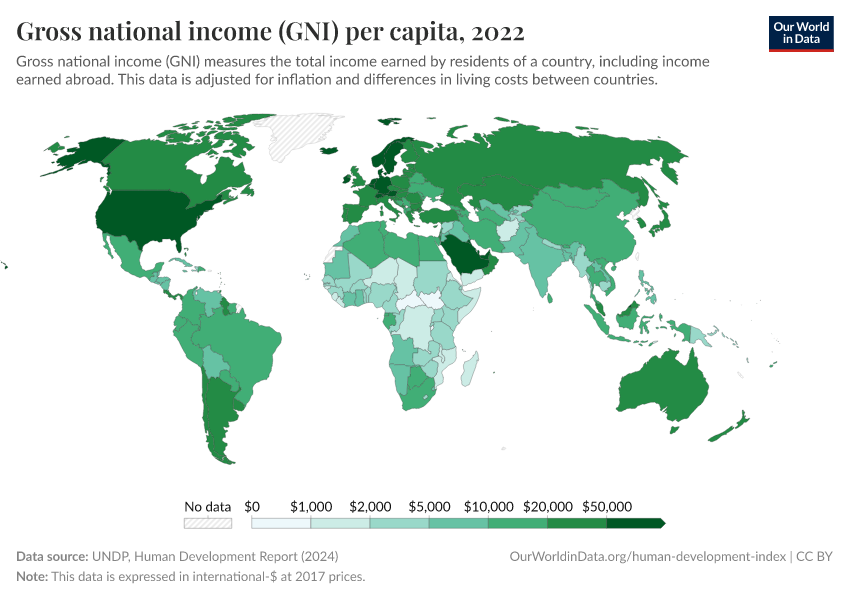Gross national income (GNI) per capita

What you should know about this indicator
- Gross national income (GNI) is a measure of the total income earned by residents of a country or region each year. It is calculated as GDP plus net income received from abroad, plus taxes (minus subsidies) on production. GNI per capita is GNI divided by population.
- This GNI per capita indicator provides information on economic growth and income levels from 1990.
- This data is adjusted for inflation and for differences in living costs between countries.
- This data is expressed in international-$ at 2021 prices.
- Higher GNI per capita typically signals greater average command over resources, but says little about distribution, non‑market production or environmental costs.
- Subject to revisions when PPP benchmarks are updated; omits remittances/leakages in informal economies; exchange‑rate mis‑measurement can bias cross‑country comparisons.
What you should know about this indicator
- Gross national income (GNI) is a measure of the total income earned by residents of a country or region each year. It is calculated as GDP plus net income received from abroad, plus taxes (minus subsidies) on production. GNI per capita is GNI divided by population.
- This GNI per capita indicator provides information on economic growth and income levels from 1990.
- This data is adjusted for inflation and for differences in living costs between countries.
- This data is expressed in international-$ at 2021 prices.
- Higher GNI per capita typically signals greater average command over resources, but says little about distribution, non‑market production or environmental costs.
- Subject to revisions when PPP benchmarks are updated; omits remittances/leakages in informal economies; exchange‑rate mis‑measurement can bias cross‑country comparisons.
Sources and processing
This data is based on the following sources
How we process data at Our World in Data
All data and visualizations on Our World in Data rely on data sourced from one or several original data providers. Preparing this original data involves several processing steps. Depending on the data, this can include standardizing country names and world region definitions, converting units, calculating derived indicators such as per capita measures, as well as adding or adapting metadata such as the name or the description given to an indicator.
At the link below you can find a detailed description of the structure of our data pipeline, including links to all the code used to prepare data across Our World in Data.
Reuse this work
- All data produced by third-party providers and made available by Our World in Data are subject to the license terms from the original providers. Our work would not be possible without the data providers we rely on, so we ask you to always cite them appropriately (see below). This is crucial to allow data providers to continue doing their work, enhancing, maintaining and updating valuable data.
- All data, visualizations, and code produced by Our World in Data are completely open access under the Creative Commons BY license. You have the permission to use, distribute, and reproduce these in any medium, provided the source and authors are credited.
Citations
How to cite this page
To cite this page overall, including any descriptions, FAQs or explanations of the data authored by Our World in Data, please use the following citation:
“Data Page: Gross national income (GNI) per capita”. Our World in Data (2025). Data adapted from UNDP, Human Development Report. Retrieved from https://archive.ourworldindata.org/20251209-133038/grapher/gross-national-income-per-capita-undp.html [online resource] (archived on December 9, 2025).How to cite this data
In-line citationIf you have limited space (e.g. in data visualizations), you can use this abbreviated in-line citation:
UNDP, Human Development Report (2025) – with minor processing by Our World in DataFull citation
UNDP, Human Development Report (2025) – with minor processing by Our World in Data. “Gross national income (GNI) per capita – UNDP – In constant international-$” [dataset]. UNDP, Human Development Report, “Human Development Report” [original data]. Retrieved December 25, 2025 from https://archive.ourworldindata.org/20251209-133038/grapher/gross-national-income-per-capita-undp.html (archived on December 9, 2025).